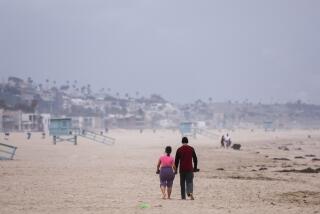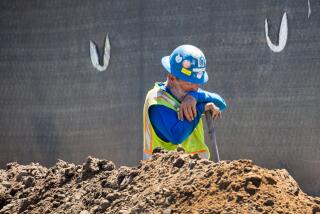August in Name Only : Weather: Cloudy skies helped keep the temperatures lower than usual, creating comfortably mild days. This month may be different.
- Share via
August, normally a time of unrelenting heat, was a month of persistently mild temperatures in the San Fernando Valley this year, continuing a trend first noticed by meteorologists in July.
Weather forecasters cited the lingering low clouds that have blanketed the Valley, but they also predict a shift toward more traditional, higher temperatures in September.
In Woodland Hills, for instance, the average daily high temperature was 92 degrees last month, a full six degrees lower than last year.
“The increased cloud cover due to the more pronounced marine layer has lowered temperatures significantly over last August,” said Alan Gibbs, special services meteorologist for WeatherData, the weather tracking service used by The Times.
Temperatures ranged from a modest high of 100 degrees in Woodland Hills on Aug. 6, to a crisp 53 degrees on Aug. 17 and 25, Gibbs said. By comparison in August of last year, temperatures ranged from a scorching 108 degrees to a cool 56 degrees.
Average daily temperatures ranged from a high of 92 degrees to a low of 59.2 degrees in Woodland Hills, both cooler averages than over the previous year, Gibbs said.
The cloudy skies meant not only cooler temperatures, but cleaner air.
“It’s been a good year,” said Kevin Durkee, a meteorologist for AQMD. “The air’s definitely better.”
So far this year, no first-stage smog alerts have been recorded for the San Fernando Valley and only two for the Santa Clarita Valley, compared to last year when seven such alerts were issued in Burbank and four in the Santa Clarita Valley, according to the South Coast Air Quality Management District (AQMD).
The trend extended throughout the Los Angeles Basin, where 18 first-stage alerts were recorded, compared to 41 for the same period last year. A first-stage alert is issued when air is considered unhealthful.
Durkee credited the cleaner air to a reduction in emissions and mild summer weather.
“Given that the day to day emissions doesn’t change very much, the weather is the most significant factor in determining smog,” Durkee said. “The wind and inversion determine how much pollution will be trapped in the atmosphere.”
Last month’s unusual weather was a continuation from a pattern that started in July when a weaker than usual high-pressure system off the Northwest permitted the jet stream to dip south. Meanwhile, the typical subtropical high in the eastern Pacific was weaker than average this year, allowing the jet stream, which normally lies in northern latitudes, to dip southward and guide storms into the Midwest and move clouds into the Southland, forecasters said.
But all that could change this month, Gibbs predicted, when temperatures are expected to be warmer than normal.
“At this point and time it looks like the jet stream has shifted a little further to the east, which means the maritime layer (or low clouds) won’t be quite as prevalent,” Gibbs said. “If you don’t have cloud cover, it will get warmer.”
Cooler August Days
Increased cloud cover and a more southern flowing jet stream made average temperatures for last month lower than those in August of 1992. Air quality was also better this year, with fewer First Stage smog alerts. Lower Temperatures Van Nuys 1992 High: 97.7 Low: 69.9 1993 High: 87.7 Low: 63.1 Northridge 1992 High: 96.1 Low: 68.0 1993 High: 85.8 Low: 62.8 Woodland Hills 1992 High: 98.1 Low: 63.6 1993 High: 92.0 Low: 59.2 Burbank 1992 High: 92.3 Low: 69.1 1993 High: 85.7 Low: 63.9 The Extremes Single highest and lowest temperatures for August 1992 and 1993: 1992 Aug. 19, Van Nuys: 108 degrees Aug. 27, Woodland Hills: 56 degrees 1993 Aug. 8, Woodland Hills: 100 degrees Aug. 17 and 25, Woodland Hills: 53 degrees First Stage alerts: Called by AQMD when ozone reaches 0.20 p.p.m. All people should avoid vigorous outdoor excercise. Susceptible people, especially those with heart or lung disease, should stay indoors. Cleaner Air Number of First Stage smong alerts for the San Fernando and Santa Clarita Valley from Jan. 1 to Aug. 31: 1992: 11 1993: 2 Sources: National Weather Service, AQMD, Weather Data
More to Read
Sign up for Essential California
The most important California stories and recommendations in your inbox every morning.
You may occasionally receive promotional content from the Los Angeles Times.













